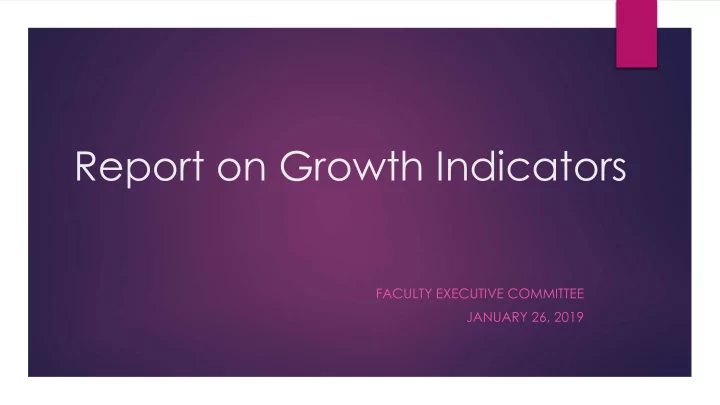

Report on G rowth I ndicators FACULTY EXECUTIVE COMMITTEE JANUARY 26, 2019
Overview FEC and others were tasked to monitor “growth indicators” as college • enrollment increased • Resources Workload • Student Experience • “Canary i n a coal mine” vs. Proactive Leadership •
Methodology Regular/Annual reporting by various faculty committees • Managed by the Assessment and Accreditation Committee • Data a nalyzed and reported to FEC • Summary report for President’s Cabinet January 23 • Report to Board of Trustees • Note that FEC is based solely on interpretation of growth indicators, while • DCC has explored other r elated factors independently
Findings AAC and FEC found: • There are some areas where there is no evidence of concern regarding growth • We also identified some areas that may warrant further monitoring and • attention There are some areas where the indicators do not provide a clear assessment of • the status There is some risk of “moving the goal posts” unless we approach these in • a larger context
Areas Where Growth Appears Wel l- Managed Student-Faculty Ratio: • • Through AY 17-18 SFR was at or below 8:1 Average Class Size: • • Remains at approximately 21 students per section Students report no decline o r negative d rop in connecti on and s atisfaction • with HMC Diversity along many axes seems to be increasing and highly supported by • entire community
Areas with Evidence of Co ncern Specific matters related t o individual committees: • • SSC petitions tripled since AY 11-12, dramatically increasing workload and need for administrative changes RPT Committee has significantly increased workload that will continue into the • future (but this is a consequence of additional faculty positions) Some i ndications of stress in student-facing support systems: • • Academic Excellence tutoring up 40% from AY11-12 to AY 16-17 Students reported decreasing satisfaction in access to psychological support • Number of students with diagnosed disability or impairment is up sharply •
Areas Where Indi cators Are not Clear Many indicators show modest change but not enough for any conc lusion • Use of average class sizes may mask impacts on Core, whi ch should • perhaps be examined separately Impacts across departments seem to vary greatly: • Departments with small number of majors • Departments with large Core footprint • HSA advising impacts and methods •
Questions Moving Forward Are faculty/staff/students acting as “shock absorbers”? (E.g., CS grutors) • Which effects are being coupled to non-growth factors, such as increase • of off-campus students? Are methods of collecting data masking slower accumulation of risk? • What are the hidden pressure points within departments, the Core, and • student services?
Recommendations Continued monitoring by F aculty Co mmittees, working in concert with • DCC Faculty undertake a review to streamline committee structure, revise the • curriculum as appropriate, and understand and alleviate impacts of off- campus majors Faculty and Administration work together to increase staff support for • students
Recommend
More recommend